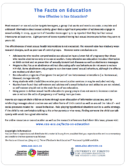How Effective is Sex Education?
How Effective is Sex Education? (92.58 kB / pdf)
DownloadMost research on sex education targets teenagers, a group that wants and needs accurate, complete and unbiased information about sexual activity given that a significant proportion of adolescents engage in sexual activity. In 2005, 43 percent of Canadian teens aged 15 to 19 reported that they had had sexual intercourse at least once. Eight percent of teens reported having had sexual intercourse before they were 15 years old.
The effectiveness of most sexual health interventions is not evaluated. The research also has relatively weak research designs, such as poor use of control groups.
However some conclusions are:
- Adolescents who receive comprehensive sex education have a lower risk of pregnancy than those who receive abstinence-only or no sex education. Comprehensive sex education includes information on birth control and on prevention of sexually transmitted diseases as well as abstinence messages.
- Programs that focus on abstinence without discussing safer sex behaviours do not seem to reduce HIV risk. Some abstinence-only programs can decrease teens’ sexual behaviors, although the effects are modest and short term.
- Sex education programs often ignore youth with non-heterosexual orientations (i.e. homosexual, bisexual, transgendered).
- Many students with disabilities receive poor sex education services or may be excluded entirely.
- Studies have found that self-esteem and adolescent’s sexual behaviour and attitudes are not related, so self-esteem should not be the main focus of sex education.
- Using peers to deliver sexual health education to young people does not seem to increase condom use or reduce the odds of pregnancy or of having more partners.
Parents can support their children at home through open discussion of information about sex, and by reinforcing messages about condom use and other forms of birth control as well as around the risks of and social pressures related to sexual behaviour. Role-playing hypothetical situations can be a useful strategy. If the child is not comfortable talking to his or her parents or vice versa, finding someone the child can talk openly with would be a good alternative.
Additional Resources For ParentsManitoba Healthy Schools:
This website gives advice to parents, teenagers and teachers on the realities of sexual health. It outlines a section on how parents can talk to their children about sex.http://www.gov.mb.ca/healthyschools/topics/sexual.html
The Sex Education and Information Council of Canada: SIECCAN is a Canadian non-profit education organization with the mission of informing the public about all aspects of human sexuality. This website links to a resource page with articles on sexual health.http://www.sieccan.org/resources.html
Alberta Health Services: This link provides a guide for parents on sexuality and developmental disability. The document was prepared by the Calgary Health Region and includes information for parents, tips on ways they may to talk to their children and a list of further resources. http://www.calgaryhealthregion.ca/programs/sexualhealth/pdf/sdd.pdf
The Society of Obstetricians and Gynecologists of Canada: This webpage includes a focus on information and tools for parents to guide their children to be sexually healthy. There are also hypothetical scenarios for parents to discuss and role-play with their children.http://www.sexualityandu.ca/en/parents
PFLAG Canada: PFLAG Canada is a national organization helping Canadians struggling with issues surrounding sexual orientation and gender identity.This link provides information for parents trying to understand their children, links to useful websites and a list of readings that may be of interest.http://www.pflagcanada.ca/en/index-e.asp
Research References Informing this IssueBennett, S.E., & Assefi, N.P. (2005). School-based teenage pregnancy prevention programs: a systematic review of randomized controlled trials. Journal of Adolescent Health. 36(1), 72-81.Duke, T. (2011).
Lesbian, gay, bisexual, and transgender youth with disabilities: a meta-synthesis. Journal of LGBT Youth. 8, 1-52.Goodson, P., Buhi, E,. & Dunsmore, M.S. (2006).
Self-esteem and adolescent sexual behaviours, attitudes, and intentions: a systematic review. Journal of Adolescent Health, 38, 310-319.Harden, A., Oakley, A., & Oliver, S. (2001)
Peer-delivered health promotion for young people: A systematic review of different study designs. Health Education Journal, 60(4), 339-353.Kim, C., & Free, C. (2008).
Recent evaluations of the peer-led approach in adolescent sexual health education: A systematic review, Perspectives on Sexual and Reproductive Health, 40(3), 144-152.McKay, A., Fisher, W., Maticka-Tyndale, E., & Barrett, M. (2001).
Adolescent sexual health education does it work? Can it work better? An analysis of recent research and media reports, The Canadian Journal of Human Sexuality, 10(3/4), 127-136.Oakley, A., & Olive, S. (2001).
Peer-delivered health promotion for young people: A systematic review of different study designs. Health Education Journal. 60(4),339-353.Oakley, A., & Fullerton, D., &Holland, J., & Arnold, S., & France-Dawson, D., & Kelly, P., &McGrellis, S. (1995)
Sexual health education interventions for young people: A methodological review. British Medical Journal, 310(6973), 158-162.Rottermann, M., (2008).
“Trends in teen sexual behaviour and condom use.”, Health Matters. Statistics Canada Catelogue no. 82-003-XPE • Health Reports, 19(3). http://www.statcan.gc.ca/pub/82-003-x/2008003/article/10664-eng.pdf ( accessed April 24, 2011).
Underhill, K., Montgomery, P., & Operario, D. (2007).
Sexual abstinence only programmes to prevent HIV infection in high income countries: systematic review. Retrieved April 10, 2011, from http://www.bmj.com/content/335/7613/248.fullWainwright, P., Thomas, J., & Jones, M. (2000).
Health promotion and the role of the school nurse: a systematic review. Journal of Advanced Nursing, 32(5), 1083-1091.

